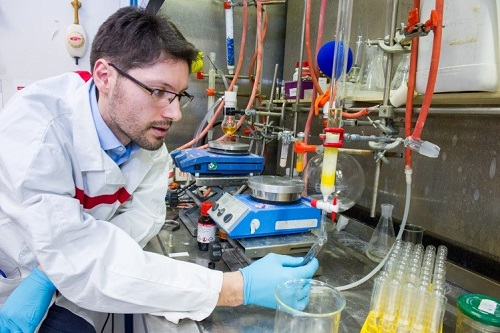The European Research Council (ERC) has just announced the list of the 301 winners of the 2019 ERC Consolidator Grant fellowships, grants awarded to scientists who have between seven and twelve years of professional experience after their PhD. Three researchers from the fundamental research division at CEA are winners in 2019 in the fields of astrophysics, particle physics and chemistry. Fundamental and applied research conducted at CEA are thus again recognized by this highly selective program.
Davide Audisio, chemist at Joliot: a top-flight chemistry for pharmacology.
Davide Audisio joined the Frédéric-Joliot Institute at CEA in 2014 and is currently in charge of the carbon 14 (14C) labeling laboratory.
« 14C-labeling is a historic activity of CEA, which is the only French academic establishment to work in this field », underlines the researcher. If 14C dating is an activity well known in the general public, it is not the same for what interests Davide Audisio and his team, although its impact in society is crucial: « 14C-labeling is used to follow the path of molecules of interest in the body, especially drug candidates during the preclinical and clinical testing phases, or in the environment, for example in the context of the development of pesticides. » More than 80% of drugs are tested using 14C-labeling before being placed on the market. It is an "invisible" labeling, that does not modify the nature of the molecule.

Davide Audisio - © CEA/Laurence Godart
What is its principle ? « Natural carbon atoms (12C) are replaced by their isotopes (14C) which are radioactive. The molecule then becomes detectable and its absorption, distribution, metabolism and excretion by the body can be followed. », explains the chemist.
This technique has been used for decades. However, current labeling processes involve many steps and generate a lot of radioactive waste. Davide Audisio's project consists to imagine and design a faster, less expensive and less polluting process. Today, the manufacture of a radio-labeled drug is made from a particularly expensive radioactive barium carbonate. The next steps build the drug brick by brick until it becomes the exact replica of the desired molecule. « We are looking to make labeling the last step in the process, he explains. We start with the drug, we cut the links with 12C which we replace with 14C. The benefits are multiple. There are far fewer steps, it is cheaper and it generates less radioactive waste. » However, this is very difficult since the chemical bond between carbon and the other atoms that make up the drug is very strong. In a collaborative work, a proof of concept has already been obtained by identifying a catalyst allowing this cut on a family of molecules and in particular on an antibiotic.
Thanks to the ERC Consolidator grant, Davide Audisio now wants to build a toolbox filled with catalysts that would allow to work on all the pharmaceutical molecules of interest.
To learn more :
https://joliot.cea.fr/drf/joliot/en/Pages/news/Science/2019/CO2-copper-carbon-label-pharmaceutical-compounds.aspx